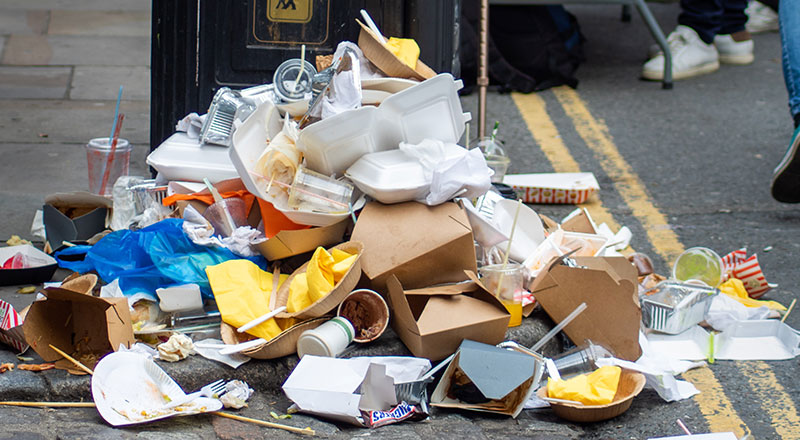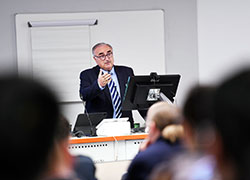Too much food is being wasted during manufacturing – Double Loop-Learning could provide the answer
By
Dr Olushola Kolawole
Lecturer in Supply Chain Management
There is a critical need to reduce food waste in our society. According to the UN Food Agriculture Organisation, the world wastes a third of the food we produce with a value of $1.3 billion every year.

Collectively, we need to address this issue to make sure there is enough food for us all, reduce food poverty, create a more circular economy and reduce the environmental impact of unconsumed food that ends up in landfill.
As individuals, we also need to hold our hands up and take responsibility. The Waste and Resources Action Programme (WRAP) has said that 70% of the food wasted in the UK in the last year came from households. This had a value of over £19 billion and was associated with 36 million tonnes of greenhouse gas emissions.
Clearly this is an issue that needs to be addressed, and thankfully there are many initiatives in place to raise awareness, including schemes like the Middlesbrough Food Partnership’s Food Action Plan here in Teesside.
What the figures from WRAP also tell us though, and which receives far less attention, is that 16% of food waste in the UK is attributable to manufacturers and inefficient processes within production plants – more than the waste that comes from the hospitality and food service sectors combined.
This is an area that needs more focus. For one thing, it is costing food manufacturing businesses money. More importantly, it is wasting huge volumes of food that people could eat. Equally, it shows a lack of alignment with UN Sustainable Development Goals related to food waste , which clearly set out the need to reduce losses in production and supply chains and halve all food waste and loss by 2030.
So the question now is – how do we address issues in production to help manufacturers achieve these important goals, and how can we get serious about reducing and even eliminating the waste that is causing so much damage?
From my research, which covers both developed and developing countries, I believe that three key things need to happen.
1. Food manufacturers need to focus more on reducing human error
Having interviewed many stakeholders within the food manufacturing industry and collected data over recent years, it’s become clear to me that one of the major root causes of food waste is human error in food processing units.
This usually happens when staff don’t follow basic standards or specifications, or make basic mistakes with the measurement of raw materials or setting the correct temperature required at various stages of food production process. Such mistakes can lead to entire production runs being lost.
Other typical problems include poor packaging systems that lead to food leakage and spoiling, machine breakdowns caused by human errors and poor transportation systems.
Manufacturers that are serious about reducing food waste and loss need to address these issues as a matter of urgency.
2. We need to apply Lean Six Sigma principles to food waste
Through my research I have also found that Lean Six Sigma principles that many manufacturers already apply to increase the efficiency of production and eliminate defects from processes should also be applied to the goal of reducing food waste.
The Lean Six Sigma tool – otherwise known as Define, Measure, Analyse, Improve and Control (DMAIC) – enables food manufacturers to define and accept that food waste is a problem and ultimately implement, control and sustain the process for improvement
However, I have also found that DMAIC cannot stand alone to solve the issue of food waste loss and manufacturers need to apply extra measures.
3. We need to reinforce the Six Sigma approach with Double Loop Learning
What I advocate is building on Lean Six Sigma principles with framework called Double Loop-Learning-DMAIC (DLL-DMAIC) that has already been tested by some food manufacturers to reduce the amount of waste in their processes.
On the back of this learning I have developed five important steps to achieving DAMIC-DLL within the context of management of food waste that I believe all manufacturers should now consider following:
Stage one – Define the problem Organisations first define the problem and create a project charter that helps them understand their specific challenges.
Stage two – Create awareness Organisations then create awareness about the problem they face – bringing in all stakeholders to help them understand that food waste loss is a major problem and that they need to discuss it regularly in all meetings.
Stage three – Identify the causes Organisation then move to identification of root causes through rigorous investigation and continuous discussion of food waste loss at all management and operational levels
Stage four – Implement improvement measures Once the first three stages have been completed, organisations then move on to determining the improvement tools that they can use to reduce each of the root causes.
Stage five – Make improvement continuous and sustainable Finally organisations work to sustain the whole process from Stage1-4 to deliver continuous improvement and long-term action on food waste loss.
Currently, figures from the Food and Drink Federation show that food is the UK’s largest manufacturing sector, contributing £29billion to the economy annually and employing over 440,000 people. Unfortunately, the sector is also experiencing a dramatic drop in confidence at the moment due to ongoing labour shortages and supply chain issues.
Some of that confidence needs to be regained, and reducing waste is a good place to start – because it could also help manufacturers to significantly increase efficiency, save costs, improve margins, drive new growth, and deliver a more sustainable and efficient food supply for us all.
If you would like to engage with the Teesside University International Business School on any of these issues and learn more about how they could benefit your business, please get in touch via TUBSBusiness@tees.ac.uk.
 Teesside University hosts groundbreaking hydrogen conference
Teesside University hosts groundbreaking hydrogen conference University supporting development of new £1m concrete plant
University supporting development of new £1m concrete plant Academic’s artwork on display at Middlesbrough station
Academic’s artwork on display at Middlesbrough station